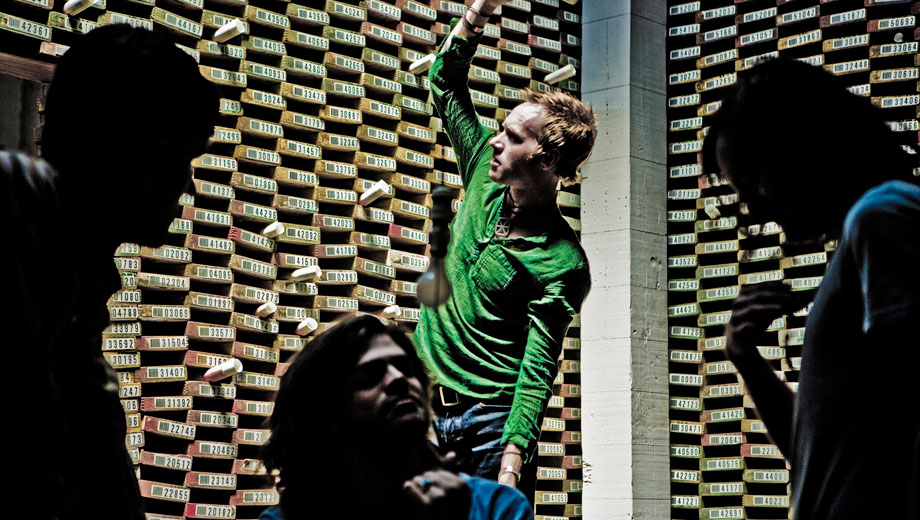
Do you remember a time before the words “dance” and “rock” were linked by a hyphen and the synthesized sounds of the ’80s were a regular part of the modern musical landscape? The members of The Faint do, because they were there when it started to happen. In fact, you could even say they’re one of the main reasons it happened at all.
On October 30, Saddle Creek will reissue one of the crown jewels of the movement, an album that over time has proven to be as influential as it is exhilarating: The Faint’s third disc, 2001’s Danse Macabre. The remastered release, which features six bonus tracks from the era as well as an extensive booklet, will be available on CD in a triple-disc format with a DVD, and on double vinyl that also includes the CDs and DVD. It’s being supported by a tour starting the first week of November that will find the group performing Danse Macabre in its entirety for the first time ever. And aside from some warm-up gigs in August and September (including The Faint’s inaugural shows at Slowdown, the Omaha club run by Saddle Creek), it will be the first time fans have been exposed to the new slim-and-trim quartet of vocalist Todd Fink, keyboardist Jacob Thiele, guitarist Dapose, and drummer Clark Baechle.
It all seems like a natural progression now, but the release of Danse Macabre’s predecessor, 1999’s Blank-Wave Arcade, was a sea change for the Omaha group, showcasing a fondness for dance beats and dark keyboards (due in part to the recent addition of Thiele) while completely moving away from the indie-rock songs found on its debut, 1998’s Media. Seeking a unique sound was becoming a regular occurrence in Omaha at the time, which led to a slew of phenomenal local releases, including Bright Eyes’ I’m Wide Awake, It’s Morning and Cursive’s The Ugly Organ, which, along with Danse Macabre, make up Saddle Creek’s holy trinity. To this day, the scene—composed of family and friends, many going back to childhood—continues to produce some of underground music’s finest moments.
“There’s still pop songwriting, and I feel like that’s the one element that really ties all those guys together,” says Saddle Creek owner Robb Nansel, who was once a member of Commander Venus with several of the scene’s major players, including Fink. “They’re all coming from the same appreciation for songwriting, a real fundamental level, so whether you paint that with keyboards or electric guitars or acoustic guitars or whatever, there’s a unity amongst all those guys.”
“We didn’t want to be an indie band,” says Fink, who changed his last name from Baechle after getting married to Azure Ray’s Orenda Fink. “We just thought, ‘We’ve heard that there are no limitations on what you can do with a keyboard, so let’s base things on that. Let’s ditch the guitar.’ We didn’t end up ditching them completely for Blank-Wave Arcade, but that was the theory behind it.”
While the band was more interested in replicating the raw feel of its basement shows on Blank-Wave, for Danse Macabre they set their sights a bit further afield, attempting to conjure the energy of bumping Berlin dance floors nearly 5,000 miles away in eastern Nebraska. The nine-song album sizzled with perfectly aggressive synth lines, Fink’s menacingly effected vocals, infectious beats, bits of industrial and goth, and, at the heart of it all, strong songwriting featuring the kind of minor-key melodies that make singing along inevitable. Lyrically, Fink moved on from the sexually-charged nature of Blank-Wave to explore themes related to the importance of living for yourself and doing what you love, most notably showcased in the ominous “Agenda Suicide.” Death-metal guitarist Dapose, who had been brought in to be the band’s art director and assist with the videos projected during live shows, eventually started adding to the music, and upstart engineer and producer Mike Mogis (whose name can be found all over Saddle Creek’s illustrious catalog) perfectly captured The Faint’s sound and attitude despite never previously working on an electronic record.
“We thought about what it would be to capture the essence of a dance club,” says Thiele. “I’m glad that the BPMs are all over the place and that we didn’t actually do a bunch of house tempos, which is more the direction we were trying to emulate. But we kind of kept it rock ’n’ roll.”
Not surprisingly, Danse Macabre gained a lot of attention, including that of major labels, though the band eventually decided to remain on its independent path. Nansel fondly recalls watching the group blow up before his eyes, a phenomenon that became more and more apparent when The Faint took its storied live show—full of sweat, smoke, eyeliner, and those invigorating strobe lights—on the road.
“I remember some of the shows at the Metro in Chicago—just seeing the crowds react was always the most rewarding moment,” says Nansel. “Seeing like 800 people, or whatever was in the room at the time, all freaking out and dancing around. We’d seen that in Omaha happen over the years, but it’s so different when you see it out of town.”
And they’re still freaking out over the band’s live performances, which take rocking and dancing to epic heights. In addition to the songs from Danse Macabre, this fall’s tour will include entries from across The Faint’s discography, which also includes 2004’s Wet From Birth and 2008’s Fasciinatiion, as well as some brand-new material. What better way to celebrate the band’s past, present, and future than with the dance party of the year?

